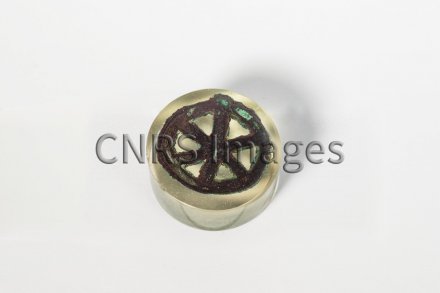Production year
2016

© Cyril FRESILLON / IPANEMA / C2RMF / CNRS Images
20160108_0013
Three-quarter view of a metallographic section of the Mehrgarh amulet. The amulet encased in a resin block was analysed by the UV/visible (180 to 1,000 nm) synchrotron photoluminescence microscope within the Disco beamline, at the SOLEIL synchrotron light source centre. A beamline serves to extract photons, select their energy range and focus the synchrotron beam on the subject. The analysis of this Chalcolithic copper amulet discovered at Mehrgarh in present-day Pakistan confirmed how it was made. This amulet is the oldest known object made by the lost wax process, which uses a model sculpted in a material like beeswax that is subsequently encased in a clay mould. Because wax melts at low temperature it runs out easily when the clay is heated. Molten metal is then poured into the clay mould, filling the empty space left by the lost wax.
The use of media visible on the CNRS Images Platform can be granted on request. Any reproduction or representation is forbidden without prior authorization from CNRS Images (except for resources under Creative Commons license).
No modification of an image may be made without the prior consent of CNRS Images.
No use of an image for advertising purposes or distribution to a third party may be made without the prior agreement of CNRS Images.
For more information, please consult our general conditions
2016
Our work is guided by the way scientists question the world around them and we translate their research into images to help people to understand the world better and to awaken their curiosity and wonderment.